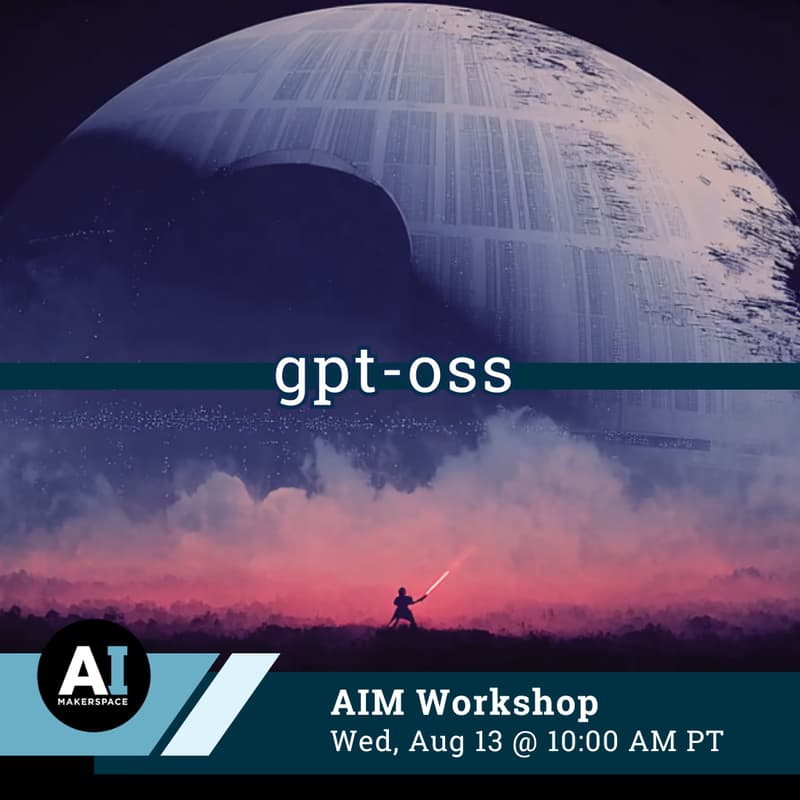

gpt-oss
Finally, OpenAI has released some truly Open AI LLM action again for us!
While we have made other models, including Whisper and CLIP available openly, gpt-oss models are our first open-weight language models since GPT‑2.
We got a release blog, a research paper on safety, and a model card!
Join us to dive deep on gpt-oss, which comes in both 120b and 20b model sizes. These models are being hailed as the “frontier of open-weight reasoning models.”
We’re excited to dig into the details that we can find about data, training processes (from pretraining to midtraining and post-training), as well as to give the model a spin and provide you with our impressions of it’s performance and vibe versus other leading models!
Here’s are the cliff notes from the top of the release blog:
Trained using a mix of SFT and reinforcement learning and techniques informed by OpenAI’s most advanced internal models
Perform strongly on tool use, few-shot function calling, CoT reasoning, and HealthBench
Compatible with our Responses API and designed to be used within agentic workflows
In a surprising move, they also backed a key safety note by a research paper entitled “Estimating Worst-Case Frontier Risks of Open-Weight LLMs.”
gpt-oss models perform comparably to our frontier models on internal safety benchmarks, offering developers the same safety standards as our recent proprietary models
Once an open-weight model is released, adversaries may be able to fine-tune the model for malicious purposes. We directly assessed these risks by fine-tuning the model on specialized biology and cybersecurity data, creating a domain-specific non-refusing version for each domain the way an attacker might
Finally, we have some details on training that we’ll dig deeper into during the session, including:
Data: mostly English, text-only dataset, with a focus on STEM, coding, and general knowledge
Architecture: GPT-style Transformer, MoE FFNs, RoPE embeddings, context length 128k
Attention Mechanism: alternating dense and locally banded sparse attention patterns, Grouped Multi-Query Attention (as we saw in AFM-4.5B)
Post-Training: Included SFT and RL aimed at aligning the models with the OpenAIModelSpec. Additionally, deliberative alignment and the instruction hierarchy were both used to teach the model to refuse unsafe prompts and defend against prompt injections. Models were been post-trained using the harmony prompt format.
Interestingly, they also seem to be engaging the open-source community with specific asks, including for supervised CoT monitoring, e.g.;
Our hope is that releasing an open model with a non-supervised chain of thought gives developers and researchers the opportunity to research and implement their own CoT monitoring systems.
All in all, there is a ton of OSS drops to review, including;
Models: gpt-oss-120b & 20b (with release blog and model card)
Tokenizer: o200k_harmony tiktoken BPE tokenizer
Prompt Template: harmony renderer
Join us live to dig into the details of the new open models from OpenAI.
🤓 Who should attend
Engineers and Data Scientists who love training models
AI Engineers and leaders who have to choose models for production that balance performance and efficiency
Any machine learning nerds like us out there interested in the state-of-the-art usage, construction, or training of LLMo today!
Speaker Bios
Dr. Greg” Loughnane is the Co-Founder & CEO of AI Makerspace, where he is an instructor for their AI Engineering Bootcamp. Since 2021, he has built and led industry-leading Machine Learning education programs. Previously, he worked as an AI product manager, a university professor teaching AI, an AI consultant and startup advisor, and an ML researcher. He loves trail running and is based in Dayton, Ohio.
Chris “The Wiz” Alexiuk is the Co-Founder & CTO at AI Makerspace, where he is an instructor for their AI Engineering Bootcamp. During the day, he is also a Developer Advocate at NVIDIA. Previously, he was a Founding Machine Learning Engineer, Data Scientist, and ML curriculum developer and instructor. He’s a YouTube content creator who’s motto is “Build, build, build!” He loves Dungeons & Dragons and is based in Toronto, Canada.
Follow AI Makerspace on LinkedIn and YouTube to stay updated about workshops, new courses, and corporate training opportunities.